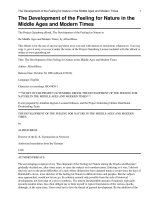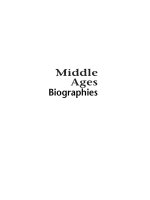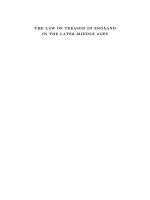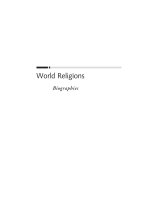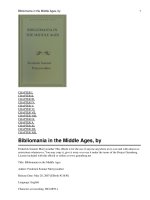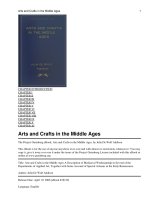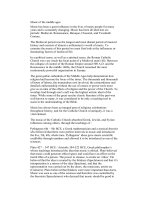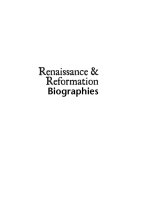Middle Ages: Biographies Volume2 J-Z potx
Bạn đang xem bản rút gọn của tài liệu. Xem và tải ngay bản đầy đủ của tài liệu tại đây (3.5 MB, 212 trang )
Biographies
MA.b-ttlpgs. qxp 3/31/04 10:07 AM Page 1
Volume 2:
J-Z
JUDSON KNIGHT
Edited by Judy Galens
Biographies
MA.b-ttlpgs. qxp 3/31/04 10:07 AM Page 3
Middle Ages: Biographies
Judson Knight
Judy Galens, Editor
Staff
Diane Sawinski, U•X•L Senior Editor
Carol DeKane Nagel, U•X•L Managing Editor
Thomas L. Romig, U•X•L Publisher
Margaret Chamberlain, Permissions Associate (Pictures)
Maria Franklin, Permissions Manager
Randy Bassett, Imaging Database Supervisor
Daniel Newell, Imaging Specialist
Pamela A. Reed, Image Coordinator
Robyn V. Young, Senior Image Editor
Rita Wimberley, Senior Buyer
Evi Seoud, Assistant Production Manager
Dorothy Maki, Manufacturing Manager
Pamela A. E. Galbreath, Senior Art Director
Kenn Zorn, Product Design Manager
Marco Di Vita, the Graphix Group, Typesetting
Cover photograph of T’ai Tsung reproduced by permission of the
Granger Collection, New York.
This publication is a creative work fully protected by all applicable copyright
laws, as well as by misappropriation, trade secret, unfair competition, and
other applicable laws. The author and editors of this work have added value
to the underlying factual material herein through one or more of the follow-
ing: unique and original selection, coordination, expression, arrangement,
and classification of the information. All rights to the publication will be vig-
orously defended.
Copyright © 2001
U•X•L, An imprint of the Gale Group
All rights reserved, including the right of reproduction in whole or in part in
any form.
Printed in the United States of America
10 9 8 7 6 5 4 3 2
Library of Congress Cataloging-in-Publication Data
Knight, Judson.
Middle ages. Biographies / Judson Knight ; Judy Galens, editor.
p. cm.
Includes bibliographical references and index.
ISBN 0-7876-4857-4 (set) — ISBN 0-7876-4858-2 (vol. 1) — ISBN
0-7876-4859-0 (vol. 2 : hardcover)
1. Biography—Middle Ages, 500-1500. 2. Civilization, Medieval. 3.
World history. I. Galens, Judy, 1968- II. Title.
CT114 .K65 2000
920’.009’02—dc21
00–064864
Reader’s Guide ix
Timeline of Events in the Middle Ages xi
Words to Know xxxi
Volume 1 (A–I)
Peter Abelard 1
Li Po (box) 4
Ala-ud-din Muhammad Khalji 9
Hindu and Buddhist Rulers of India (box) 10
Muhammad ibn Tughluq (box) 13
Alexander Nevsky 15
Heroes of Catholic Europe (box) 18
Augustine 23
Simeon Stylites the Elder (box) 27
Averroës 31
Priscian (box) 36
v
Contents
Basil II 39
King Alfred the Great (box) 40
Sundiata Keita (box) 42
Bernard of Clairvaux 47
Shem Tov ibn Shem Tov and His Family (box) . . 49
Boethius 53
Ashikaga Takauji (box) 56
Charlemagne 61
Christine de Pisan 69
Queen Margaret of Denmark (box) 71
Clovis 77
King Arthur (box) 80
St. Cyril and St. Methodius 85
Olga and Vladimir (box) 87
Dante Alighieri 91
Omar Khayyám (box) 94
El Cid 97
Harun al-Rashid (box) 98
Eleanor of Aquitaine 105
King John (box) 108
English Scholars, Thinkers, and Writers
(Alcuin, St. Anselm of Canterbury, Thomas
à Becket, William of Ockham, and
Geoffrey Chaucer) 113
St. Francis of Assisi 121
St. Dominic (box) 124
Genghis Khan 129
Brian Boru (box) 132
Gregory I 137
Boniface VIII (box) 140
Gregory VII and Henry IV 145
Matilda of Tuscany (box) 148
Henry the Navigator 153
Cheng Ho (box) 156
Middle Ages: Biographiesvi
Historians (The Venerable Bede, Al-Mas’udi,
Ssu-ma Kuang, and Anna Comnena) 161
Holy Roman Emperors
(Otto the Great, Otto III, Frederick I Barbarossa,
and Frederick II) 169
Innocent III 177
Benedict of Nursia (box) 178
Urban II (box) 180
Irene of Athens 185
Yang Kuei-fei (box) 188
Volume 2 (J–Z)
Joan of Arc 191
William Wallace (box) 196
Justinian 199
Theodora (box) 204
Kublai Khan 209
Rabban Bar Sauma (box) 213
Leif Eriksson 217
Other Medieval Explorers and
Geographers (box) 220
Moses Maimonides 223
Avicenna (box) 226
Mansa Musa 229
Harsha (box) 231
Mathematicians and Scientists
(Aryabhata, al-Khwarizmi, al-Razi, Alhazen,
and Roger Bacon) 235
Two Great Byzantines (box) 236
Mohammad I Askia 243
Charles the Bold (box) 246
Montezuma I 251
Muhammad 257
Murasaki Shikibu 265
Giovanni Boccaccio (box) 266
Contents vii
Osman I 273
Balkan Heroes (box) 274
Pachacutec Inca Yupanqui 281
Jayavarman VII (box) 284
St. Patrick 289
A Gallery of Saints (box) 292
Marco Polo 297
Ibn Battuta (box) 302
Rabia al-Adawiyya 305
Julian of Norwich (box) 309
Joachim of Fiore (box) 311
Richard I 313
Saladin 321
Leaders of the First Crusade (box) 324
Shotoku Taishi 329
Toghril Beg (box) 331
T’ai Tsung 335
Two Other Dynasties, Two Other Families (box) . 338
Emperor Tenchi and Fujiwara Kamatari (box) . . 341
Tamerlane 343
Vlad Tepes (box) 346
Thomas Aquinas 349
Some Notable Thinkers and Scholars
of the Middle Ages (box) 352
Wen Ti 357
People Who Took Power from Outside (box) . . 360
William the Conqueror 365
Wu Ze-tian 371
Fredegund (box) 373
Index xli
Middle Ages: Biographiesviii
T
he Middle Ages was an era of great changes in civilization,
a transition between ancient times and the modern
world. Lasting roughly from
A.D. 500 to 1500, the period saw
the growth of the Roman Catholic Church in Western Europe
and the spread of the Islamic faith in the Middle East. Around
the world, empires—the Byzantine, Mongol, and Incan—rose
and fell, and the first nation-states emerged in France, Eng-
land, and Spain. Despite the beauty of illuminated manu-
scripts, soaring Gothic cathedrals, and the literary classics of
Augustine and Dante, Europe’s civilization lagged far behind
that of the technologically advanced, administratively orga-
nized, and economically wealthy realms of the Arab world,
West Africa, India, and China.
Middle Ages: Biographies (two volumes) presents the
life stories of fifty people who lived during the Middle Ages.
Included are such major rulers as Charlemagne, Genghis
Khan, and Eleanor of Aquitaine; thinkers and writers Augus-
tine and Thomas Aquinas; religious leaders Muhammad and
Francis of Assisi; and great explorers Marco Polo and Leif
Eriksson. Also featured are lesser-known figures from the era,
ix
Reader’s Guide
including Wu Ze-tian and Irene of Athens, the only female
rulers in the history of China and Byzantium, respectively;
Mansa Musa, leader of the great empire of Mali in Africa;
Japanese woman author Murasaki Shikibu, who penned the
world’s first novel; and Pachacutec, Inca emperor recognized
as among the greatest rulers in history.
Additional features
Over one hundred illustrations and dozens of sidebar
boxes exploring high-interest people and topics bring the text
to life. Definitions of unfamiliar terms and a list of books and
Web sites to consult for more information are included in
each entry. The volume also contains a timeline of events, a
general glossary, and an index offering easy access to the peo-
ple, places, and subjects discussed throughout Middle Ages: Bi-
ographies.
Dedication
To Margaret, my mother; to Deidre, my wife; and to
Tyler, my daughter.
Comments and suggestions
We welcome your comments on this work as well as
your suggestions for topics to be featured in future editions of
Middle Ages: Biographies. Please write: Editors, Middle Ages: Bi-
ographies, U•X•L, 27500 Drake Rd., Farmington Hills, MI
48331-3535; call toll-free: 1-800-877-4253; fax: 248-699-8097;
or send e-mail via www.galegroup.com.
Middle Ages: Biographiesx
180 The death of Roman emperor Marcus Aurelius marks
the end of the “Pax Romana,” or Roman peace. Years
of instability follow, and although Rome recovers nu-
merous times, this is the beginning of Rome’s three-
century decline.
312 Roman emperor Constantine converts to Christianity.
As a result, the empire that once persecuted Chris-
tians will embrace their religion and eventually will
begin to persecute other religions.
325 Constantine calls the Council of Nicaea, first of many
ecumenical councils at which gatherings of bishops
determine official church policy.
330 Constantine establishes Byzantium as eastern capital
of the Roman Empire.
395 After the death of Emperor Theodosius, the Roman
Empire is permanently divided in half. As time pass-
es, the Eastern Roman Empire (later known as the
Byzantine Empire) distances itself from the declining
Western Roman Empire.
xi
Timeline of Events
in the Middle Ages
410 Led by Alaric, the Visigoths sack Rome, dealing the
Western Roman Empire a blow from which it will
never recover.
413–425 Deeply affected—as are most Roman citizens—by
the Visigoths’ attack on Rome, Augustine writes City
of God, one of the most important books of the Mid-
dle Ages.
455 The Vandals sack Rome.
c. 459 Death of St. Patrick, missionary who converted Ire-
land to Christianity.
476 The German leader Odoacer removes Emperor Romu-
lus Augustulus and crowns himself “king of Italy.”
This incident marks the end of the Western Roman
Empire.
481 The Merovingian Age, named for the only powerful
dynasty in Western Europe during the period, begins
when Clovis takes the throne in France.
496 Clovis converts to Christianity. By establishing strong
ties with the pope, he forges a strong church-state re-
lationship that will continue throughout the me-
dieval period.
500 Date commonly cited as beginning of Middle Ages.
500–1000 Era in European history often referred to as the
Dark Ages, or Early Middle Ages.
524 The philosopher Boethius, from the last generation
of classically educated Romans, dies in jail, probably
at the orders of the Ostrogoth chieftain Theodoric.
529 Benedict of Nursia and his followers establish the
monastery at Monte Cassino, Italy. This marks the be-
ginning of the monastic tradition in Europe.
532 Thanks in large part to the counsel of his wife
Theodora, Justinian—greatest of Byzantine emper-
ors—takes a strong stand in the Nika Revolt, ensuring
his continued power.
534–563 Belisarius and other generals under orders from Jus-
tinian recapture much of the Western Roman Empire,
including parts of Italy, Spain, and North Africa. The
victories are costly, however, and soon after Justin-
Middle Ages: Biographiesxii
ian’s death these lands will fall back into the hands of
barbarian tribes such as the Vandals and Lombards.
535 Justinian establishes his legal code, a model for the
laws in many Western nations today.
540 The Huns, or Hunas, destroy India’s Gupta Empire,
plunging much of the subcontinent into a state of an-
archy.
c. 550 Death of Indian mathematician Aryabhata, one of
the first mathematicians to use the numeral zero.
589 The ruthless Wen Ti places all of China under the rule
of his Sui dynasty, ending more than three centuries
of upheaval.
590 Pope Gregory I begins his fourteen-year reign. Also
known as Gregory the Great, he ensures the survival
of the church, and becomes one of its greatest me-
dieval leaders.
Late 500s The first Turks begin moving westward, toward the
Middle East, from their homeland to the north and
west of China.
604 Prince Shotoku Taishi of Japan issues his “Seventeen-
Article Constitution.”
c. 610 An Arab merchant named Muhammad receives the
first of some 650 revelations that form the basis of the
Koran, Islam’s holy book.
618 In China, T’ai Tsung and his father Kao Tsu over-
throw the cruel Sui dynasty, establishing the highly
powerful and efficient T’ang dynasty.
622 Muhammad and his followers escape the city of
Mecca. This event, known as the hegira, marks the be-
ginning of the Muslim calendar.
632–661 Following the death of Muhammad, the Arab Mus-
lims are led by a series of four caliphs who greatly ex-
pand Muslim territories to include most of the Middle
East.
645 A conspiracy to murder the Japanese emperor places
the reform-minded Emperor Tenchi on the throne
and puts the Fujiwara clan—destined to remain influ-
ential for centuries—in a position of power.
Timeline xiii
661 The fifth caliph, Mu’awiya, founds the Umayyad
caliphate, which will rule the Muslim world from
Damascus, Syria, until 750.
690 Wu Ze-tian becomes sole empress of China. She will
reign until 705, the only female ruler in four thou-
sand years of Chinese history.
711 Moors from North Africa invade Spain, taking over
from the Visigoths. Muslims will rule parts of the Iber-
ian Peninsula until 1492.
711 Arabs invade the Sind in western India, establishing a
Muslim foothold on the Indian subcontinent.
727 In Greece, the Iconoclasts begin a sixty-year war on
icons, or images of saints and other religious figures,
which they consider idols. Though the Greek Ortho-
dox Church ultimately rejects iconoclasm, the contro-
versy helps widen a growing division between Eastern
and Western Christianity.
731 The Venerable Bede publishes his Ecclesiastical Histo-
ry of the English People, his most important work.
732 A force led by Charles Martel repels Moorish invaders
at Tours, halting Islam’s advance into Western Europe.
750 A descendant of Muhammad’s uncle Abbas begins
killing off all the Umayyad leaders and establishes the
Abbasid caliphate in Baghdad, Iraq.
751 The Carolingian Age begins when Charles Martel’s
son Pepin III, with the support of the pope, removes
the last Merovingian king from power.
751 Defeated by Arab armies at Talas, China’s T’ang dy-
nasty begins to decline. A revolt led by An Lu-shan in
755 adds to its troubles.
768 Reign of Charlemagne, greatest ruler of Western Eu-
rope during the Early Middle Ages, begins.
782 English scholar Alcuin goes to France, on the invita-
tion of Charlemagne, to organize a school for future
officials in the Carolingian empire.
787 Irene of Athens convenes the Seventh Council of
Nicaea, which restores the use of icons in worship.
Middle Ages: Biographiesxiv
793 Viking raiders destroy the church at Lindisfarne off
the coast of England. Lindisfarne was one of the
places where civilized learning had weathered the
darkest years of the Middle Ages. Thus begins two
centuries of terror as more invaders pour out of Scan-
dinavia and spread throughout Europe.
797 Having murdered her son, Irene of Athens—who ac-
tually ruled from 780 onward—officially becomes
Byzantine empress, the only woman ruler in the em-
pire’s eleven-hundred-year history. It is partly in reac-
tion to Irene that the pope later crowns Charlemagne
emperor of Western Europe.
800s Feudalism takes shape in Western Europe.
800 Pope Leo III crowns Charlemagne “Emperor of All
the Romans.” This marks the beginning of the politi-
cal alliance later to take shape under Otto the Great
as the Holy Roman Empire.
c. 800 The Khmers, or Cambodians, adopt Hinduism under
the leadership of their first powerful king, Jayavarman
II, founder of the Angkor Empire.
801 Death of Rabia al-Adawiyya, a woman and former
slave who founded the mystic Sufi sect of Islam.
820 A group of Vikings settles in northwestern France,
where they will become known as Normans.
843 In the Treaty of Verdun, Charlemagne’s son Louis the
Pious divides the Carolingian Empire among his three
sons. These three parts come to be known as the West
Frankish Empire, consisting chiefly of modern France;
the “Middle Kingdom,” a strip running from what is
now the Netherlands all the way down to Italy; and
the East Frankish Empire, or modern Germany. The
Middle Kingdom soon dissolves into a patchwork of
tiny principalities.
c. 850 Death of Arab mathematician al-Khwarizmi, who
coined the term “algebra” and who is often consid-
ered the greatest mathematician of the Middle Ages.
860 Vikings discover Iceland.
Timeline xv
863 St. Cyril and St. Methodius, two Greek priests, be-
come missionaries to the Slavs of Central and Eastern
Europe. As a result, the Greek Orthodox version of
Christianity spreads throughout the region, along
with the Cyrillic alphabet, which the brothers create
in order to translate the Bible into local languages.
886 King Alfred the Great captures London from the
Danes, and for the first time in British history unites
all Anglo-Saxons.
907 China’s T’ang dynasty comes to an end after almost
three centuries of rule, and the empire enters a period
of instability known as “Five Dynasties and Ten King-
doms.”
911 The last of the Carolingian line in the East Frankish
Empire dies. Seven years later, Henry the Fowler of
Saxony, father of Otto the Great, takes leadership of
the German states.
c. 930 Arab physician al-Razi writes his most important
work, The Comprehensive Book, which sums up the
medical knowledge of the era.
955 German king Otto I defeats a tribe of nomadic in-
vaders called the Magyars. The Magyars later become
Christianized and found the nation of Hungary; as for
Otto, thenceforth he is known as Otto the Great.
957 Death of al-Mas’udi, perhaps the greatest historian of
the Arab world.
960 In China, troops loyal to Chao K’uang-yin declare
him emperor, initiating the Sung dynasty.
962 Having conquered most of Central Europe, Otto the
Great is crowned emperor in Rome, reviving Charle-
magne’s title. From this point on, most German kings
are also crowned ruler of the Holy Roman Empire.
982 Vikings discover Greenland. Four years later, Erik the
Red founds a permanent settlement there.
987 Russia converts to Greek Orthodox Christianity and
gradually begins adopting Byzantine culture after
Vladimir the Great marries Anne, sister of Emperor
Basil II.
Middle Ages: Biographiesxvi
987 The last Carolingian ruler of France dies without an
heir, and Hugh Capet takes the throne, establishing a
dynasty that will last until 1328.
1000–1300 Era in European history often referred to as the
High Middle Ages.
1001 Vikings led by Leif Eriksson sail westward to North
America, and during the next two decades conduct a
number of raids on the coast of what is now Canada.
1001 A second Muslim invasion of the Indian subconti-
nent, this time by Turks, takes place as the Ghaz-
navids subdue a large region in what is now
Afghanistan, Pakistan, and western India.
1002 Holy Roman Emperor Otto III dies at the age of
twenty-two, and with him die his grand dreams of a
revived Roman Empire.
1002 In Japan, Murasaki Shikibu begins writing the Tale of
Genji, the world’s first novel.
1014 After years of conflict with the Bulgarians, Byzantine
Emperor Basil II defeats them. He orders that ninety-
nine of every one hundred men be blinded and the
last man allowed to keep just one eye so he can lead
the others home. Bulgaria’s Czar Samuel dies of a
heart attack when he sees his men, and Basil earns the
nickname “Bulgar-Slayer.”
1025 Basil II dies, having taken the Byzantine Empire to its
greatest height since Justinian five centuries earlier;
however, it begins a rapid decline soon afterward.
1039 Death of Arab mathematician and physicist Alhazen,
the first scientist to form an accurate theory of optics,
or the mechanics of vision.
1054 After centuries of disagreement over numerous issues,
the Greek Orthodox Church and the Roman Catholic
Church officially separate.
1060 Five years after Turks seize control of Baghdad from
the declining Abbasid caliphate, their leader, Toghril
Beg, declares himself sultan and thus establishes the
Seljuk dynasty.
Timeline xvii
1066 William the Conqueror leads an invading force that
defeats an Anglo-Saxon army at Hastings and wins
control of England. The Norman invasion is the most
important event of medieval English history, greatly
affecting the future of English culture and language.
1071 The Seljuk Turks defeat Byzantine forces at the Battle
of Manzikert in Armenia. As a result, the Turks gain a
foothold in Asia Minor (today known as Turkey), and
the Byzantine Empire begins a long, slow decline.
1071 A Norman warlord named Robert Guiscard drives the
last Byzantine forces out of Italy. Byzantium had con-
trolled parts of the peninsula since the time of Justin-
ian.
1072 Robert Guiscard’s brother Roger expels the Arabs from
Sicily, and takes control of the island.
1075–77 Pope Gregory VII and Holy Roman Emperor Henry
IV become embroiled in a church-state struggle called
the Investiture Controversy, a debate over whether
popes or emperors should have the right to appoint
local bishops. Deserted by his supporters, Henry
stands barefoot in the snow for three days outside the
gates of a castle in Canossa, Italy, waiting to beg the
pope’s forgiveness.
1084 Reversing the results of an earlier round in the In-
vestiture Controversy, Henry IV takes Rome and
forcibly removes Gregory VII from power. The pope
dies soon afterward, broken and humiliated.
1084 Ssu-ma Kuang, an official in the Sung dynasty, com-
pletes his monumental history of China, Comprehen-
sive Mirror for Aid in Government.
1094 Troops under the leadership of Rodrigo Díaz de
Vivar—better known as El Cid—defeat the Moorish
Almoravids at Valencia. This victory, and the charac-
ter of El Cid himself, becomes a symbol of the Recon-
quista, the Christian effort to reclaim Spain from its
Muslim conquerors.
1094 Norman warrior Bohemond, son of Robert Guiscard,
takes control of Rome from Henry IV and hands the
city over to Pope Urban II. Fearing the Normans’
Middle Ages: Biographiesxviii
power and aware that he owes them a great debt,
Urban looks for something to divert their attention.
1095 Byzantine Emperor Alexis Comnenus asks Urban II
for military assistance against the Turks. Urban
preaches a sermon to raise support at the Council of
Clermont in France, and in the resulting fervor the
First Crusade begins. Among its leaders are Bohemond
and his nephew Tancred.
1096–97 A pathetic sideshow called the Peasants’ Crusade
plays out before the real First Crusade gets underway.
The peasants begin by robbing and killing thousands
of Jews in Germany; then, led by Peter the Hermit,
they march toward the Holy Land, wreaking havoc as
they go. In Anatolia, a local Turkish sultan leads them
into a trap, and most of the peasants are killed.
1099 The First Crusade ends in victory for the Europeans as
they conquer Jerusalem. It is a costly victory, howev-
er—one in which thousands of innocent Muslims, as
well as many Europeans, have been brutally slaugh-
tered—and it sows resentment between Muslims and
Christians that remains strong today.
c. 1100–1300 Many of the aspects of life most commonly as-
sociated with the Middle Ages, including heraldry and
chivalry, make their appearance in Western Europe
during this period. Returning crusaders adapt the de-
fensive architecture they observed in fortresses of the
Holy Land, resulting in the familiar design of the me-
dieval castle. This is also the era of romantic and
heroic tales such as those of King Arthur.
1105 King Henry I of England and St. Anselm of Canter-
bury, head of the English church, sign an agreement
settling their differences. This is an important mile-
stone in church-state relations and serves as the
model for the Concordat of Worms seventeen years
later.
1118 After being banished because of her part in a conspir-
acy against her brother, the Byzantine emperor, Anna
Comnena begins writing the Alexiad, a history of
Byzantium in the period 1069–1118.
Timeline xix
1140 After a career in which he infuriated many with his
unconventional views on God, French philosopher
Peter Abelard is charged with heresy by Bernard of
Clairvaux and forced to publicly refute his beliefs.
c. 1140 In Cambodia, Khmer emperor Suryavarman II devel-
ops the splendid temple complex of Angkor Wat.
1146 After the Muslims’ capture of Edessa in 1144, Pope
Eugenius III calls on the help of his former teacher,
Bernard of Clairvaux, who makes a speech that leads
to the launching of the Second Crusade.
1147–49 In the disastrous Second Crusade, armies from Eu-
rope are double-crossed by their crusader allies in the
Latin Kingdom of Jerusalem. They fail to recapture
Edessa and suffer a heavy defeat at Damascus. Among
the people who take part in the crusade (though not
as a combatant) is Eleanor of Aquitaine.
1154 After the death of England’s King Stephen, Henry II
takes the throne, beginning the long Plantaganet dy-
nasty. With Henry is his new bride, Eleanor of
Aquitaine. Now queen of England, she had been
queen of France two years earlier, before the annul-
ment of her marriage to King Louis VII.
1158 Holy Roman Emperor Frederick I Barbarossa estab-
lishes Europe’s first university at Bologna, Italy.
1159 Frederick I Barbarossa begins a quarter-century of
fruitless, costly wars in which the Ghibellines and
Guelphs—factions representing pro-imperial and pro-
church forces, respectively—fight for control of
northern Italy.
1162 Moses Maimonides, greatest Jewish philosopher of
the Middle Ages, publishes his Letter Concerning Apos-
tasy, the first of many important works by him that
will appear over the next four decades.
1165 A letter supposedly written by Prester John, a Christ-
ian monarch in the East, appears in Europe. Over the
centuries that follow, Europeans will search in vain
for Prester John, hoping for his aid in their war
against Muslim forces. Even as Europe enters the
modern era, early proponents of exploration such as
Middle Ages: Biographiesxx
Henry the Navigator will remain inspired by the
quest for Prester John’s kingdom.
1170 Knights loyal to Henry II murder the archbishop
Thomas à Becket in his cathedral at Canterbury.
1174–80 Arab philosopher Averroës writes one of his most
important works, The Incoherence of the Incoherence, a
response to hard-line Muslim attacks on his belief
that reason and religious faith can coexist.
1183 Frederick I Barbarossa signs the Peace of Constance
with the cities of the Lombard League, and thus ends
his long war in northern Italy. After this he will con-
centrate his attention on Germany and institute re-
forms that make him a hero in his homeland.
1185 For the first time, Japan comes under the rule of a
shogun, or military dictator. Shoguns will remain in
power for the next four centuries.
1187 Muslim armies under Saladin deal the crusaders a
devastating blow at the Battle of Hittin in Palestine.
Shortly afterward, Saladin leads his armies in the re-
conquest of Jerusalem.
1189 In response to Saladin’s victories, Europeans launch
the Third Crusade. Of the crusade’s three principal
leaders, Emperor Frederick I Barbarossa drowns on
his way to the Holy Land, and Richard I takes a num-
ber of detours, only arriving in 1191. This leaves
Philip II Augustus of France to fight the Muslims
alone.
1191 Led by Richard I of England and Philip II of France,
crusaders take the city of Acre in Palestine.
1192 Richard I signs a treaty with Saladin, ending the
Third Crusade.
1198 Pope Innocent III begins an eighteen-year reign that
marks the high point of the church’s power. Despite
his great influence, however, when he calls for a new
crusade to the Holy Land, he gets little response—a
sign that the spirit behind the Crusades is dying.
c. 1200 Cambodia’s Khmer Empire reaches its height under
Jayavarman VII.
Timeline xxi
1202 Four years after the initial plea from the pope, the
Fourth Crusade begins. Instead of going to the Holy
Land, however, the crusaders become involved in a
power struggle for the Byzantine throne.
1204 Acting on orders from the powerful city-state of
Venice, crusaders take Constantinople, forcing the
Byzantines to retreat to Trebizond in Turkey. The
Fourth Crusade ends with the establishment of the
Latin Empire.
1206 Qutb-ud-Din Aybak, the first independent Muslim
ruler in India, establishes the Delhi Sultanate.
1206 Genghis Khan unites the Mongols for the first time
in their history and soon afterward leads them to war
against the Sung dynasty in China.
1208 Pope Innocent III launches the Albigensian Crusade
against the Cathars, a heretical sect in southern
France.
1209 St. Francis of Assisi establishes the Franciscan order.
1215 In Rome, Pope Innocent III convenes the Fourth Lat-
eran Council. A number of traditions, such as regular
confession of sin to a priest, are established at this,
one of the most significant ecumenical councils in
history.
1215 English noblemen force King John to sign the Magna
Carta, which grants much greater power to the nobili-
ty. Ultimately the agreement will lead to increased
freedom for the people from the power of both king
and nobles.
1217–21 In the Fifth Crusade, armies from England, Ger-
many, Hungary, and Austria attempt unsuccessfully to
conquer Egypt.
1227 Genghis Khan dies, having conquered much of
China and Central Asia, thus laying the foundation
for the largest empire in history.
1228–29 The Sixth Crusade, led by Holy Roman Emperor
Frederick II, results in a treaty that briefly restores
Christian control of Jerusalem—and does so with a
minimum of bloodshed.
Middle Ages: Biographiesxxii
1229 The brutal Albigensian Crusade ends. Not only are the
Cathars destroyed, but so is much of the French no-
bility, thus greatly strengthening the power of the
French king.
1231 Pope Gregory IX establishes the Inquisition, a court
through which the church will investigate, try, and
punish cases of heresy.
c. 1235 The empire of Mali, most powerful realm in sub-Sa-
haran Africa at the time, takes shape under the lead-
ership of Sundiata Keita.
1239–40 In the Seventh Crusade, Europeans make another
failed attempt to retake the Holy Land.
1241 After six years of campaigns in which they sliced
across Russia and Eastern Europe, a Mongol force is
poised to take Vienna, Austria, and thus to swarm
into Western Europe. But when their leader, Batu
Khan, learns that the Great Khan Ogodai is dead, he
rushes back to the Mongol capital at Karakorum to
participate in choosing a successor.
1242 Alexander Nevsky and his brother Andrew lead the
Russians’ defense of Novgorod against invaders from
Germany.
1243 Back on the warpath, but this time in the Middle East,
the Mongols defeat the last remnants of the Seljuk
Turks.
1248–54 King Louis IX of France (St. Louis) leads the Eighth
Crusade, this time against the Mamluks. The result is
the same: yet another defeat for the Europeans.
1252 In Egypt, a group of former slave soldiers called the
Mamluks take power from the Ayyubid dynasty, es-
tablished many years before by Saladin.
1260 The Mamluks become the first force to defeat the
Mongols, in a battle at Goliath Spring in Palestine.
1260 Kublai Khan, greatest Mongol leader after his grand-
father Genghis Khan, is declared Great Khan, or
leader of the Mongols.
1261 Led by Michael VIII Palaeologus, the Byzantines re-
capture Constantinople from the Latin Empire, and
Timeline xxiii
Byzantium enjoys one last gasp of power before it
goes into terminal decline.
1270–72 In the Ninth Crusade, last of the numbered crusades,
King Louis IX of France again leads the Europeans
against the Mamluks, who defeat European forces yet
again.
1271 Marco Polo embarks on his celebrated journey to the
East, which lasts twenty-four years.
1273 The Hapsburg dynasty—destined to remain a major
factor in European politics until 1918—takes control
of the Holy Roman Empire.
1273 Italian philosopher and theologian Thomas Aquinas
completes the crowning work of his career, the mon-
umental Summa theologica. The influential book will
help lead to wider acceptance of the idea, introduced
earlier by Moses Maimonides, Averroës, and
Abelard, that reason and faith are compatible.
1279 Mongol forces under Kublai Khan win final victory
over China’s Sung dynasty. Thus begins the Yüan dy-
nasty, the first time in Chinese history when the
country has been ruled by foreigners.
1291 Mamluks conquer the last Christian stronghold at
Acre, bringing to an end two centuries of crusades to
conquer the Holy Land for Christendom.
1292 Death of Roger Bacon, one of Europe’s most impor-
tant scientists. His work helped to show the rebirth of
scientific curiosity taking place in Europe as a result of
contact with the Arab world during the Crusades.
1294 At the death of Kublai Khan, the Mongol realm is the
largest empire in history, covering most of Asia and a
large part of Europe. Within less than a century, how-
ever, this vast empire will have all but disappeared.
1299 Turkish chieftain Osman I refuses to pay tribute to
the local Mongol rulers, marking the beginnings of
the Ottoman Empire.
1300–1500 Era in European history often referred to as the
Late Middle Ages.
Middle Ages: Biographiesxxiv
1303 After years of conflict with Pope Boniface VIII,
France’s King Philip the Fair briefly has the pope ar-
rested. This event and its aftermath marks the low
point of the papacy during the Middle Ages.
1308 Dante Alighieri begins writing the Divine Comedy,
which he will complete shortly before his death in
1321.
1309 Pope Clement V, an ally of Philip the Fair, moves the
papal seat from Rome to Avignon in southern France.
1309 After years of fighting, Sultan Ala-ud-din Muham-
mad Khalji subdues most of India.
1324 Mansa Musa, emperor of Mali, embarks on a pilgrim-
age to Mecca. After stopping in Cairo, Egypt, and
spending so much gold that he affects the region’s
economy for years, he becomes famous throughout
the Western world: the first sub-Saharan African ruler
widely known among Europeans.
1328 Because of a dispute between the Franciscans and the
papacy, William of Ockham, one of the late me-
dieval period’s most important philosophers, is forced
to flee the papal court. He remains under the protec-
tion of the Holy Roman emperor for the rest of his
life.
1337 England and France begin fighting what will become
known as the Hundred Years’ War, an on-again, off-
again struggle to control parts of France.
1347–51 Europe experiences one of the worst disasters in
human history, an epidemic called the Black Death.
Sometimes called simply “the Plague,” in four years
the Black Death kills some thirty-five million people,
or approximately one-third of the European popula-
tion in 1300.
1368 Led by Chu Yüan-chang, a group of rebels overthrows
the Mongol Yüan dynasty of China and establishes
the Ming dynasty, China’s last native-born ruling
house.
1378 The Catholic Church becomes embroiled in the Great
Schism, which will last until 1417. During this time,
Timeline xxv
there are rival popes in Rome and Avignon; and from
1409 to 1417, there is even a third pope in Pisa, Italy.
1383 Tamerlane embarks on two decades of conquest in
which he strikes devastating blows against empires in
Turkey, Russia, and India and subdues a large portion
of central and southwestern Asia.
1386 Geoffrey Chaucer begins writing the Canterbury
Tales.
1389 Ottoman forces defeat the Serbs in battle at Kosovo
Field. As a result, all of Southeastern Europe except for
Greece falls under Turkish control.
1390 Tamerlane attacks and severely weakens the Golden
Horde even though its leaders come from the same
Mongol and Tatar ancestry as he.
1392 General Yi Song-ye seizes power in Korea and estab-
lishes a dynasty that will remain in control until
1910.
1398 Tamerlane sacks the Indian city of Delhi, hastening
the end of the Delhi Sultanate, which comes in 1413.
1402 After conquering much of Iran and surrounding areas
and then moving westward, Tamerlane defeats the
Ottoman sultan Bajazed in battle. An unexpected re-
sult of their defeat is that the Ottomans, who seemed
poised to take over much of Europe, go into a period
of decline.
1404–05 Christine de Pisan, Europe’s first female profes-
sional writer, publishes The Book of the City of Ladies,
her most celebrated work.
1405 Ming dynasty emperor Yung-lo sends Admiral Cheng
Ho on the first of seven westward voyages. These take
place over the next quarter-century, during which
time Chinese ships travel as far as East Africa.
1417 The Council of Constance ends the Great Schism, af-
firming that Rome is the seat of the church and that
Pope Martin V is its sole leader. Unfortunately for the
church, the Great Schism has weakened it at the very
time that it faces its greatest challenge ever: a gather-
Middle Ages: Biographiesxxvi
